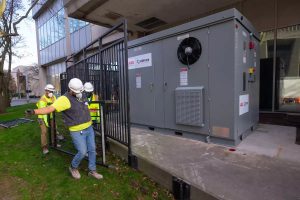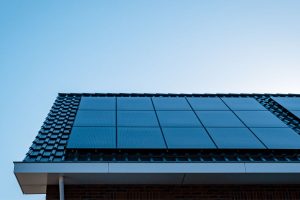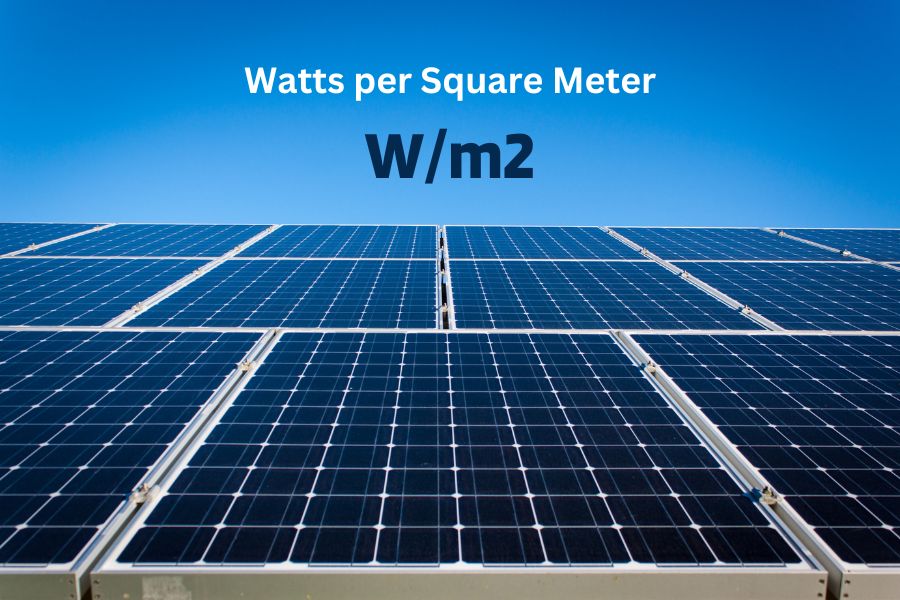
Solar Panels Watts per Square Meter
Solar panels are at the forefront of innovation and sustainability when it comes to renewable energy sources. Harnessing the power of the sun to generate electricity is an eco-friendly solution with significant potential for powering our world. But how do we measure the efficiency of solar panels? One of the key metrics is “watts per square meter.”
The kilowatt hours to amp hours calculator then converts the energy output of solar panels from kilowatt-hours to ampere-hours, a unit that’s more practical when designing and evaluating energy storage systems like batteries.
This article will discuss what this metric means, how it affects solar panel performance, and what factors can influence it.
Understanding Watts per Square Meter
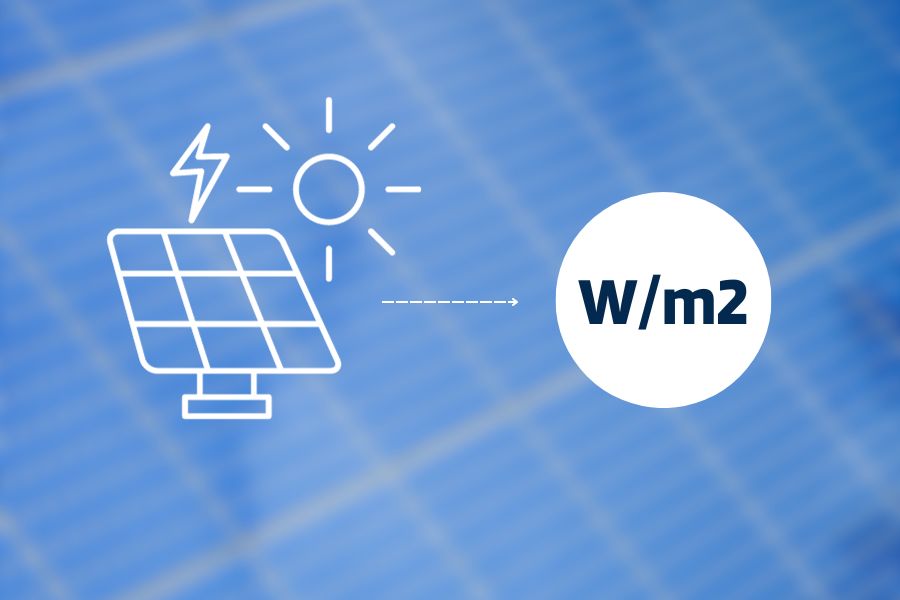
We must first break down the terminology to grasp the concept of watts per square meter. A “watt” is a power unit, representing the energy transfer or consumption rate. When we talk about a solar panel, watts are a measure of the electricity it can generate under standard conditions.
A “square meter,” on the other hand, is a unit of area, typically used to denote the size or surface area of the solar panel. So, when we say “watts per square meter,” we are essentially measuring how much power a solar panel can produce relative to its physical size.
This metric, watts per square meter, serves as a fundamental yardstick for evaluating the efficiency of a solar panel system. It tells us how effectively solar panels produce electricity based on their size, making it easier to compare different solar panel models and systems.
Solar panels produce electricity when sunlight is exposed; the watts per square meter metric helps us quantify this energy conversion. It allows us to gauge the effectiveness of a solar panel in harnessing the sun’s energy and converting it into usable electricity.
The Importance of Efficiency
When it comes to harnessing solar power, the efficiency of solar panels is paramount. These panels come in various types and models, each with its own unique level of efficiency.
An efficient solar panel can produce more electricity per square meter than a less efficient one, making it a crucial consideration in the world of solar power. This is where the “watts per square meter” metric comes into play.
Efficiency significantly determines how many solar panels are needed to meet specific power output goals. A more efficient panel can generate more electricity in the same space, reducing the number of solar panels installed. This optimizes the use of available space and lowers costs for homeowners and businesses alike.
Understanding the efficiency of a typical solar panel is vital for calculating the power output of a solar panel system accurately. A higher-efficiency panel will yield more energy from the same amount of sunlight, making it a wise investment for those looking to maximize their solar power generation.
As solar technology continues to advance, we can look forward to even more efficient solar panels that make solar power a more accessible and affordable option for a sustainable energy future.
Factors Affecting Watts per Square Meter
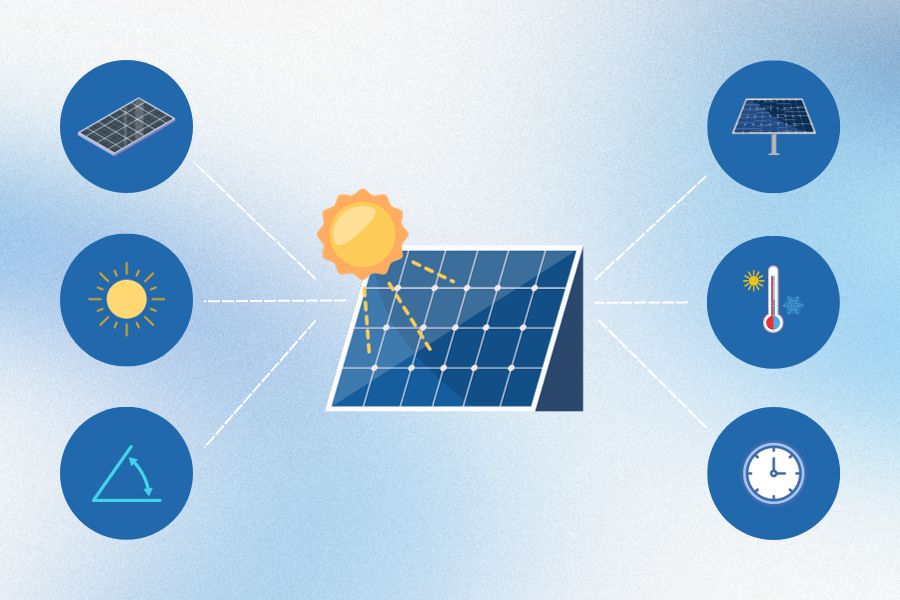
Several factors influence the watts per square meter output of solar panels. Understanding these factors can help you make informed decisions when choosing the right solar system for your home or business:
Solar Cell Type
In the fascinating world of solar power, the type of solar cell employed can make all the difference in efficiently harnessing the sun’s energy. Various solar cell technologies are at our disposal, each with unique characteristics and efficiency levels.
These distinctions can significantly influence the amount of energy a solar panel can produce, thus impacting the number of solar panels required to achieve specific solar panel output goals.
At the top of the efficiency pyramid, we find monocrystalline solar cells, celebrated for their remarkable energy conversion capabilities. Crafted from a single crystal structure, these cells are adept at converting a substantial portion of sunlight into electricity.
The high efficiency of monocrystalline cells means that they can generate more electricity per square meter than other solar cell types, effectively reducing the number of panels needed to meet your solar panel output requirements.
On the other hand, thin-film solar cells, while still valuable, generally exhibit lower efficiency levels compared to monocrystalline cells. This lower efficiency necessitates more surface area to generate the same amount of power, impacting how many solar panels are needed for a specific solar panel output.
Polycrystalline cells fall between monocrystalline and thin-film cells in terms of efficiency. These cells strike a balance between cost-effectiveness and performance, making them a popular choice for many solar panel installations.
Polycrystalline cells fit the bill when you aim for an efficient solar panel without incurring the premium cost of monocrystalline cells.
Sunlight Intensity
When it comes to understanding how solar panels work and how much electricity they can produce, the intensity of sunlight in a given location is a pivotal factor. The level of sunlight a region receives significantly impacts a solar panel’s power output. Unsurprisingly, solar panels are especially popular in areas where sunlight is abundant, such as arid deserts.
In sun-drenched regions, the intensity of sunlight is consistently high, leading to more energy production. The more intense the sunlight, the more efficiently solar panels can convert it into electricity, resulting in a higher watts per square meter rating. This is why many people choose to harness the power of the sun by installing solar panels in such areas
It’s a practical and sustainable solution for meeting energy needs, taking advantage of the generous sunlight to generate more power and reduce energy bills.
It’s important to note that even in less sunny regions, solar panels can still be a viable and environmentally friendly energy source. While the watts per square meter may be lower, modern solar technology continues improving, making solar panels a valuable option for sunny and less sunny locations.
Understanding sunlight intensity and its impact on solar panel power output can help you make informed decisions when considering the installation of solar panels.
Angle and Tilt
The angle and tilt of solar panels are crucial factors in determining how much energy a solar panel can produce. Solar panels are most efficient when they are optimally positioned to face the sun. This means that the orientation of the panels relative to the sun’s path throughout the day can significantly impact their solar panel output.
Solar panels are traditionally installed at a fixed angle that is based on the location’s latitude to maximize overall energy production. However, these fixed installations have limitations as they are not adjusted to follow the sun’s path in real-time. This is where tracking systems come into play.
Solar tracking systems adjust the angle and tilt of the panels throughout the day to ensure they are constantly facing the sun. As a result, panels in such installations can produce more electricity compared to fixed ones.
The impact of angle and tilt on a solar panel’s efficiency is particularly evident in areas with variable sun angles during the day. By ensuring that the panels always face the sun directly, tracking systems can optimize the solar panel output, ultimately producing more electricity.
While tracking systems require more complex and costly setups, they can be a valuable investment in regions with significant variations in sun angles.
Shading
While solar panels are a reliable source of energy, they are susceptible to external factors that can affect how much energy a solar panel can produce. Shading, in particular, can significantly impact a solar panel’s efficiency and overall solar panel output.
Obstructions such as trees, buildings, or even accumulated dust and dirt on the solar panels can cast shadows. These shadows reduce the amount of sunlight the solar panel receives, which, in turn, affects how much energy a solar panel produces. When shadows fall on a solar panel, the affected area generates less electricity, decreasing the overall solar panel output.
To maximize efficiency and ensure you’re getting the most out of your solar panel system, keeping the panels free from obstructions that might cause shading is vital. Regular cleaning and maintenance can help remove dust and dirt, while strategic placement and trimming of nearby trees or structures can mitigate shading issues.
By taking steps to prevent shading, you can enhance how much electricity your solar panel produces and ultimately reap the full benefits of your investment in solar energy.
Temperature
Temperature plays a vital role in the efficiency of solar panels. These energy-generating wonders are sensitive to extreme temperatures. Surprisingly, while they thrive in sunlight, excessive heat can decrease their efficiency, affecting their solar panel output and how much electricity they can produce.
A solar panel generates electricity through the photovoltaic effect, which works most efficiently at moderate temperatures. When panels overheat, their efficiency drops, leading to a decrease in solar panel output. To maximize a solar panel’s potential, choosing a location that offers a good balance of sunlight and moderate temperatures is crucial.
Proper installation techniques and cooling mechanisms may be necessary to maintain efficiency in regions with scorching summers. By optimizing the temperature conditions surrounding your solar panels, you can ensure that they consistently produce the maximum energy, making your investment in solar energy both sustainable and cost-effective.
Panel Age
Solar panels are known for their durability and longevity, but like any technology, they are subject to the passage of time. As solar panels age, they may experience a slight decrease in efficiency. This gradual decline is a normal part of their life cycle.
When assessing solar panel performance, it’s important to consider their initial efficiency and long-term sustainability. Over the years, factors like exposure to the elements and wear and tear can significantly reduce how much energy solar panels produce.
This underscores the importance of making a well-informed investment in solar energy. While solar panels can maintain their efficiency for many years, understanding that they may become slightly less efficient over time can help you plan for long-term performance and ensure that your solar panels continue to produce the energy you rely on.
Comparing Solar Panels
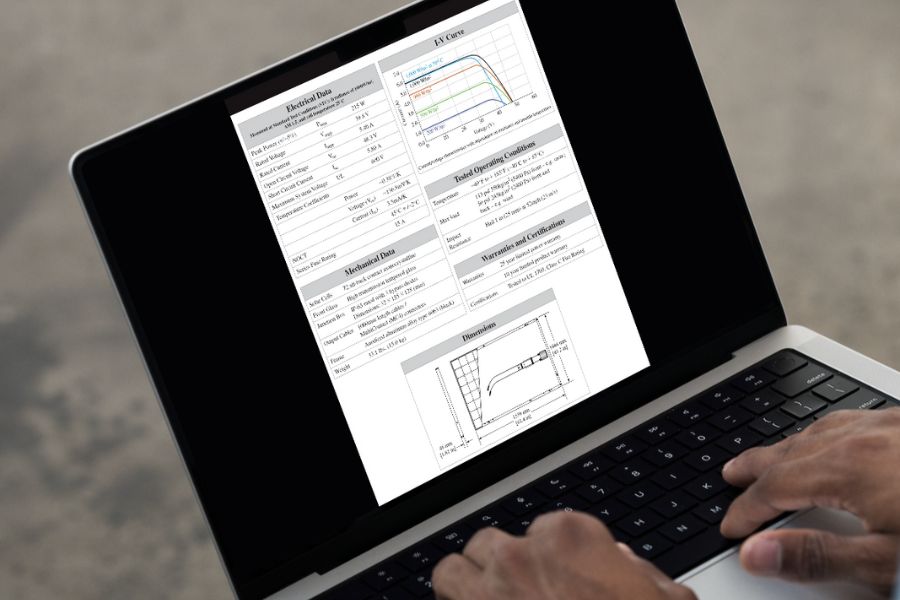
When shopping for solar panels, you may come across data sheets or specifications that provide the watts per square meter rating. This is a valuable point of comparison between models of solar panels.
Make sure to also consider the costs of the panels, warranty, and aforementioned factors that may affect efficiency.
Practical Applications
Understanding watts per square meter is not just for solar panel manufacturers and energy enthusiasts. It’s also vital for those considering solar energy for their homes or businesses.
When planning a solar installation, knowing the watts per square meter rating of the panels can help you determine how many panels you need to meet your energy requirements. It can also guide the positioning and setup of the panels for optimal efficiency.
The Future of Solar Panel Efficiency
The world of solar technology is continuously evolving. Scientists and engineers are working on improving the efficiency of solar panels to maximize energy production. New materials, advanced manufacturing techniques, and innovative designs are all contributing to the future of solar energy.
As these technologies develop, we can expect to see even higher watts per square meter ratings for solar panels, making them even more attractive for sustainable energy solutions.
Conclusion
Solar panels have become a symbol of clean, renewable energy. Understanding the concept of “watts per square meter” is crucial for assessing their efficiency and making informed choices.
As technology advances and solar panel efficiency continues to improve, we can look forward to a brighter, more sustainable future powered by the sun.
The next time you consider going solar, you’ll have a better grasp of how to make the most of every square meter of sunlight.

